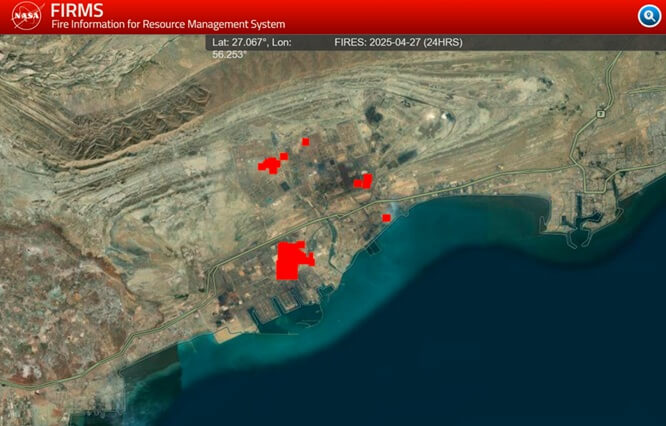Updated: At Least 1,200 Injured in Blast at Bandar Abbas

[Updated] A huge explosion in the commercial port of Bandar Abbas in Iran at 12.00 on the morning of April 26 has injured at least 1,000, according to Iranian state media. First reports suggested that four people have been killed, a toll which had risen to 40 overnight. Office buildings in the port have been damaged and glass blown out of windows, although the immediate neighborhood is a commercial rather than a residential area. Explosions were still occurring in the area several hours after the initial explosion.
Footage shows the moment an explosion occurred in Shahid Rajaee Port, Bandar Abbas. pic.twitter.com/Sjl1X9LJqP
— IRNA News Agency (@IrnaEnglish) April 26, 2025
Fire continues to spread to nearby containers as fire fighters attempt to control the blaze at Bandar Abbas' Shahid Rajaei port.
— PressTV Extra (@PresstvExtra) April 26, 2025
Follow Press TV on Telegram: https://t.co/0EMmcJs6DL pic.twitter.com/6usWBzXrWE
The explosion is believed to have started in a container stored in the hazardous and flammable section of the container park. An extensive container storage park lies immediately to the north of the port’s container loading quays.
New footage has been released, showing the moment that yesterday’s chemical fire started at the port of Bandar Abbas on the coast of the Persian Gulf, which resulted in a massive explosion causing severe damage to the port and the deaths of at least 28 workers in Southern Iran. pic.twitter.com/ym9MSTi5mV
— OSINTdefender (@sentdefender) April 27, 2025
Russia's emergency ministry said Sunday that it would be dispatching two aircraft to help Iranian officials address the fire, including a Beriev Be-200 amphibious firefighting plane and an Ilyushin Il-76 transport aircraft.
The Shahid Rajaei commercial port handles about 85% of Iran’s non-oil and gas exports and imports, and is connected to Iran’s transnational rail network. The Iranian authorities have for some years been planning an expansion of the port to increase throughput. The commercial port lies 10 miles to the west of the Bandar Abbas Naval Harbor, which is the homeport to most of Iran’s regular Navy.
In February and March, the Maritime Executive tracked the progress from China of two sanctioned ships owned by Islamic Republic of Iran Shipping Lines (IRISL), MV Golbon and MV Jairan, which then unloaded their cargoes of sodium perchlorate at Bandar Abbas. Sodium perchlorate is processed into ammonium perchlorate rocket fuel at the Iranian facilities at Parchin south of Tehran and Khojir. Ammonium perchlorate makes up 70% of the standard fuel load of most of Iran’s solid-fueled ballistic missiles, such as medium range Khybar-Shikan and Fattah missiles, and the shorter range Fateh-110 and Zolfaghar missiles. It is not known if containers unloaded from the two ships were, several weeks after unloading, still in the Sina container port at the time of the explosion, or whether the containers formed the seat of the explosion.
As would be expected, an Israeli spokesman denied any knowledge of the explosion, although the Times of Israel was the first media organization to point out a possible connection. Washington Institute missile expert Farzin Nadimi has said that he believes the yellow character of the explosive fireball is indicative of the presence of sodium. Within Iran, newspapers are split on the cause of the explosion, conservatives blaming safety failures and reformists blaming sabotage, implicity accepting the target was the sodium perchlorate.

The fire/heat source detected by the NASA fire-detecting system FIRMS grew in size throughout April 26, inicating that the fire continued to burn into nightfall; other heat spots initially detected were from oil refineries and the Hormozgan steel works (FIRMS/CJRC).
The NASA FIRMS system which monitors fires and heat sources initially detected only a small fire, which grew as the day wore on. On the afternoon of April 27, the fire was still spreading. Other regular heat spots to the north of the fire, namely oil refineries and the Hormozgan steel works, have since yesterday gone cold, suggesting that these industrial facilities have been closed down, possibly because workers have been evacuated. At least 10,000 containers hve been destroyed, and there is likely to be long-term damage to the port, with operations likely to be disrupted for some time.
